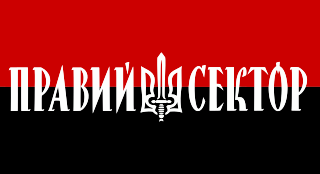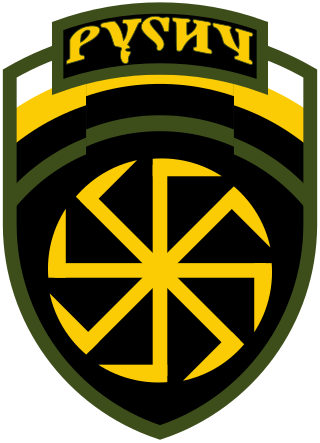
Right Sector is a loosely defined coalition of right-wing to far-right Ukrainian nationalist organizations. It originated in November 2013 as a right-wing, paramilitary confederation of several ultranationalist organizations at the Euromaidan revolt in Kyiv, where its street fighters participated in clashes with riot police. The coalition became a political party on 22 March 2014, at which time it claimed to have roughly 10,000 members. Founding groups included the Trident (Tryzub), led by Dmytro Yarosh and Andriy Tarasenko, and the Ukrainian National Assembly–Ukrainian National Self-Defense (UNA–UNSO), a political and paramilitary organization. Other founding groups included the Social-National Assembly, and its Patriot of Ukraine paramilitary wing, White Hammer, and the Sich Battalion. White Hammer was expelled in March 2014, and Patriot of Ukraine left the organization, along with many UNA–UNSO members, in the following months.

From the end of February 2014, demonstrations by Russian-backed, pro-Russian, and anti-government groups took place in major cities across the eastern and southern regions of Ukraine in the aftermath of the Euromaidan and the Revolution of Dignity, which resulted in the ousting of Russian-leaning President Viktor Yanukovych. The unrest, which was supported by Russian military and intelligence, belongs to the early stages of the Russo-Ukrainian War.

Pavel Yuryevich Gubarev is a Ukrainian-born Russian public figure, primarily known for his activities in Donbas in 2014.

The National Guard of Ukraine is the Ukrainian national gendarmerie and internal military force. It is part of the Ministry of Internal Affairs, responsible for public security. Originally created as an agency under the direct control of the Verkhovna Rada on 4 November 1991, following Ukrainian independence, it was later disbanded and merged into the Internal Troops of Ukraine in 2000 by then-President Leonid Kuchma as part of a "cost-saving" scheme. Following the 2014 Revolution of Dignity, amidst the Russian intervention, the National Guard was re-established, and the Internal Troops were disbanded.

The Donetsk People's Republic is an internationally unrecognized republic of Russia, comprising the occupied parts of eastern Ukraine's Donetsk Oblast, with its capital in Donetsk. The DPR was created by Russian-backed paramilitaries in 2014, and it initially operated as a breakaway state until it was annexed by Russia in 2022.

The People's Militia of the Donetsk People's Republic and People's Militia of the Luhansk People's Republic are pro-Russian paramilitaries in the Donbas region of eastern Ukraine, under the overall control of the Russian Federation. They are also referred to as Russian separatist forces or Russian proxy forces. They were affiliated with the self-declared Donetsk People's Republic (DPR) and Luhansk People's Republic (LPR) during the war in Donbas (2014–2022), the first stage of the Russo-Ukrainian War. They then supported the Russian Armed Forces against the Ukrainian Armed Forces during the 2022 Russian invasion. In September 2022, Russia annexed the DPR and LPR, and began integrating the paramilitaries into its armed forces. They are designated as terrorist groups by the government of Ukraine.

The war in Donbas, or Donbas war, was a phase of the Russo-Ukrainian War in the Donbas region of Ukraine. The war began 12 April 2014, when a fifty-man commando unit headed by Russian citizen Igor Girkin seized Sloviansk in Donetsk oblast. The Ukrainian military launched an operation against them. It continued until it was subsumed by the Russian invasion of Ukraine in February 2022.

The Luhansk People's Republic or Lugansk People's Republic is an internationally unrecognised republic of Russia in the occupied parts of eastern Ukraine's Luhansk Oblast, with its capital in Luhansk. The LPR was proclaimed by Russian-backed paramilitaries in 2014, and it initially operated as a breakaway state until it was annexed by Russia in 2022.
Novorossiya or New Russia, also referred to as the Union of People's Republics, was a project for a confederation between the self-proclaimed Donetsk People's Republic (DPR) and the Luhansk People's Republic (LPR) in Eastern Ukraine, both of which were under the control of pro-Russian separatists.

Igor Venediktovich Plotnitsky is a former Ukrainian separatist leader who served as the head of the self-proclaimed Luhansk People's Republic, in eastern Ukraine, from 14 August 2014 to 24 November 2017. He was born 26 June 1964 either in Luhansk or in the town of Kelmentsi, Chernivtsi Oblast. Plotnitsky himself did not issue a public statement on 24 November 2017, but on that day a Luhansk People's Republic website claimed he had resigned as their president. On 25 November the 38-member People's Council of the self-proclaimed state unanimously approved Plotnitsky's resignation.

Aleksey Borisovich Mozgovoy or Mozgovoi was a commander of the self-proclaimed Luhansk People's Republic in Ukraine. He was the leader of the pro-Russian Prizrak Brigade and also served as "judge" on the "People's Court", notorious for issuing controversial death sentences.

In early 2014, there were clashes between rival groups of protestors in the Ukrainian city of Odesa, during the pro-Russian unrest that followed the Ukrainian Revolution. The street clashes were between pro-unity protesters and anti-government (anti-Maidan), pro-Russian protesters. Violence erupted on 2 May, when a 'United Ukraine' rally was attacked by pro-Russian separatists. Stones, petrol bombs and gunfire were exchanged; two pro-Ukraine activists and four pro-Russia activists were shot dead in the clashes. The pro-Ukraine protesters then moved to dismantle a pro-Russian protest camp in Kulykove Pole, causing some pro-Russian activists to barricade themselves in the nearby Trade Unions House. Shots were fired by both sides, and the pro-Ukraine protesters attempted to storm the building, which caught fire as the two groups threw petrol bombs at each other.

The Prizrak Brigade (Russian: Бригада «Призрак», romanized: Brigada "Prizrak", lit. 'Ghost Brigade'), founded by Aleksey Mozgovoy, is an infantry unit of the Luhansk People's Republic (LPR), one of the self-proclaimed breakaway states located in the Donbas. It has been officially designated Prizrak Mechanized Brigade and 4th Territorial Defense Brigade (Alchevsk). According to Amnesty International, the unit is one of the separatist units known for brutal treatment and torture of prisoners of war.
During Ukraine's post-Soviet history, the far-right has remained on the political periphery and been largely excluded from national politics since independence in 1991. Unlike most Eastern European countries which saw far-right groups become permanent fixtures in their countries' politics during the decline and the Dissolution of the Soviet Union in 1991, the national electoral support for far-right parties in Ukraine only rarely exceeded 3% of the popular vote. Far-right parties usually enjoyed just a few wins in single-mandate districts, and no far right candidate for president has ever secured more than 5 percent of the popular vote in an election. Only once in the 1994–2014 period was a radical right-wing party elected to the parliament as an independent organization within the proportional part of the voting: Svoboda in 2012. Since then far-right parties have failed to gain enough votes to attain political representation, even at the height of nationalist sentiment during and after Russia's annexation of Crimea and the Russo-Ukrainian War.

Leonid Ivanovich Pasechnik is a Ukrainian-born politician who has served as Head of the Luhansk People's Republic (LPR) since 2017. He holds the position in acting capacity ever since the illegal and unrecognized Russian annexation of Donetsk, Kherson, Luhansk and Zaporizhzhia oblasts in 2022. Pasechnik had previously held office as the LPR's Minister of State Security from 2014 to 2018.
The Russo-Ukrainian War has seen foreign volunteers participate on both sides of the conflict. Most foreign fighters joined the conflict during one of two waves. The first wave happened from 2014 to 2019 during the War in the Donbas and consisted of approximately 17,241 foreign fighters. The second wave is considered by researchers to have been much larger and began in 2022 after the Russian invasion of Ukraine.

The Battles of Sievierodonetsk were a series of battles between Ukrainian troops and Luhansk People's Republic formations during the war in Donbas in and around the Eastern Ukrainian cluster of cities of Rubizhne, Lysychansk, and Sieverodonetsk for control. Although the battle derives its namesake from the city, there was no fighting in Sieverodonetsk itself, in comparison to the successive battle in 2022.
The battle of Popasna was a military engagement during the Eastern Ukraine campaign as part of the Battle of the Donbas, the battle began on March 3, 2022, and ended on May 7, 2022.

The Sabotage Assault Reconnaissance Group(DShRG) "Rusich" is a Russian far-right and neo-Nazi paramilitary unit that has been fighting against Ukrainian forces in the Russo-Ukrainian War. Its co-founder and leader is Alexey Milchakov and operates within the Wagner Group. "Rusich" fought on the side of pro-Russian military in the Donbas war from June 2014 to July 2015, and in the Russian invasion of Ukraine alongside Russian troops.
The Odessa Brigade was a pro-Russian separatist militant group operating in Ukraine during the war in Donbas. Odessa Brigade or Odesa Brigade may also refer to:
















